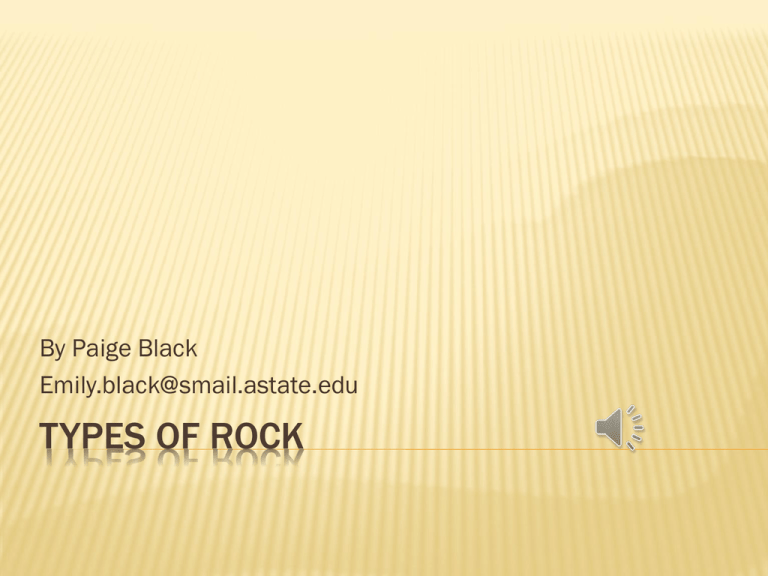Power Point Presentation
advertisement

By Paige Black Emily.black@smail.astate.edu TYPES OF ROCK WHAT ARE ROCKS? A rock is a naturally occurring solid mixture of one or more minerals, or organic matter. Rocks are classified by how they are formed, their composition, and texture. Rocks change over time through the rock cycle. 3 TYPES OF ROCKS Igneous Rocks Sedimentary Rocks Examples: granite, basalt, pumice, flint Examples: limestone, chalk, sandstone Metamorphic Rocks Examples: slate, marble, quartzite IGNEOUS ROCKS These are rocks that solidified directly from magma. Magma can form: When rock is heated When pressure is released When rock changes composition Magma freezes between 700˚C and 1,250˚C. Magma is a mixture of many minerals. IGNEOUS ROCKS Types of Composition: Felsic- light colored rocks that are rich in elements such as aluminum, potassium, silicon, and sodium Mafic- dark colored rocks that are rich in calcium, iron, and magnesium, poor in silicon Coarse-grained- takes longer to cool, giving mineral crystals more time to grow Fine-grained- cools quickly with little to no crystals IGNEOUS ROCKS Types of Formation: Intrusive- magma pushes into surrounding rock below the Earth’s surface Extrusive- magma erupts onto the Earth’s surface (lava), cools quickly with very small or no crystals formed SEDIMENTARY ROCKS The rocks are formed when igneous rocks are eroded as a sediment under the sea. Sediments are moved from one place to another. Sediments are deposited in layers, with the older ones on the bottom. The layers become compacted and cemented together. SEDIMENTARY ROCKS Three Types: Clastic- made of fragments of rock cemented together with calcite or quartz o Chemical- minerals crystallize out of solution to become rock o Example: Sandstone Example: Halite (Rock Salt) Organic- any accumulation of sedimentary debris caused by organic processes o Example: Coal METAMORPHIC ROCKS Means “change in form” Changes with temperature and pressure, but remains solid Usually takes place deep in the Earth Make up a lot of the Earth’s crust METAMORPHIC ROCKS Two Types: Contact- when magma is injected into the surrounding rock solid. Increased temperature changes the composition of the rock, minerals are changed into new minerals. Regional- changes in great masses of rock over a wide area. Large pieces of the Earth’s crust collide and the rock is deformed and chemically changed by heat and pressure. METAMORPHIC ROCKS Two Types of Texture: Foliated- contain aligned grains of flat minerals o Example: Slate Non-foliated- mineral grains are not arranged in bands or plains o Example: Marble 3 TYPES OF ROCKS Igneous Sedimentary Metamorphic RESOURCES http://jersey.uoregon.edu/~mstrick/AskGeoMan/geo Querry13.html http://en.wikipedia.org/wiki/Igneous_rock http://en.wikipedia.org/wiki/Sedimentary_rock http://en.wikipedia.org/wiki/Metamorphic_rock Google Images for Pictures






